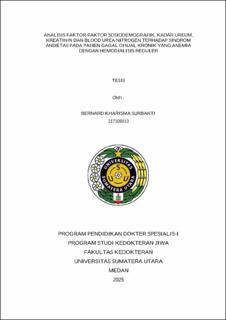| dc.description.abstract | Background: Chronic kidney disease (CKD) is a progressive and irreversible condition characterized by elevated serum levels of urea, creatinine, and blood urea nitrogen (BUN). One of its major complications is anemia caused by erythropoietin deficiency, which significantly impairs patients’ quality of life. CKD patients with anemia undergoing regular hemodialysis face not only physiological burdens but also psychological challenges, including anxiety. Sociodemographic factors and biochemical biomarkers play an important role in the development of anxiety syndrome; however, comprehensive studies on these associations remain limited.. Methods: This analytical cross-sectional study was conducted in the Hemodialysis Unit of H. Adam Malik General Hospital, Medan, from April to June 2025. A total of 113 CKD patients with anemia (hemoglobin <10 g/dL), aged 18–60 years, undergoing regular hemodialysis were included. Independent variables comprised age, sex, marital status, duration and frequency of hemodialysis, serum urea, creatinine, and BUN levels. The dependent variable was anxiety syndrome, assessed using the Hospital Anxiety and Depression Scale (HADS ≥7). Data were analyzed with chi-square tests and multivariate logistic regression using the backward method. Results: Most patients were older than 40 years (83.2%), male (51.3%), and married (77%). Anxiety syndrome was identified in 71.7% of subjects. Multivariate analysis demonstrated significant associations between anxiety and age (p=0.010), duration of hemodialysis (p=0.008), urea (p=0.002), and BUN (p=0.022). Advanced age and elevated urea increased anxiety risk, while hemodialysis duration >6 months and lower BUN acted as protective factors. Conclusion: Age, duration of hemodialysis, urea, and BUN levels are significantly associated with anxiety syndrome in CKD patients with anemia on regular hemodialysis. These findings underscore the importance of a multidisciplinary approach integrating medical treatment and psychosocial support in patient management. | en_US |


